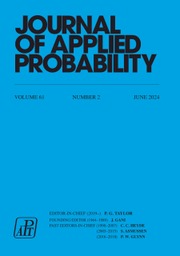Crossref Citations
This article has been cited by the following publications. This list is generated based on data provided by
Crossref.
Renshaw, Eric
1986.
A survey of stepping-stone models in population dynamics.
Advances in Applied Probability,
Vol. 18,
Issue. 03,
p.
581.
Cartwright, Donald I.
1988.
Random walks on direct sums of discrete groups.
Journal of Theoretical Probability,
Vol. 1,
Issue. 4,
p.
341.
Dawson, D. A.
and
Hochberg, K. J.
1991.
A multilevel branching model.
Advances in Applied Probability,
Vol. 23,
Issue. 04,
p.
701.
Dawson, Donald A.
and
Greven, Andreas
1993.
Stochastic Processes.
p.
41.
Dawson, Donald A.
and
Greven, Andreas
1993.
Hierarchical models of interacting diffusions: Multiple time scale phenomena, phase transition and pattern of cluster-formation.
Probability Theory and Related Fields,
Vol. 96,
Issue. 4,
p.
435.
Fleischmann, Klaus
and
Greven, Andreas
1994.
Diffusive clustering in an infinite system of hierarchically interacting diffusions.
Probability Theory and Related Fields,
Vol. 98,
Issue. 4,
p.
517.
Dawson, Donald
1995.
Proceedings of the International Congress of Mathematicians.
p.
986.
Evans, Steven N.
and
Fleischmann, Klaus
1996.
Cluster formation in a stepping-stone model with continuous, hierarchically structured sites.
The Annals of Probability,
Vol. 24,
Issue. 4,
Fleischmann, Klaus
and
Greven, Andreas
1996.
Time-Space Analysis of the Cluster-Formation in Interacting Diffusions.
Electronic Journal of Probability,
Vol. 1,
Issue. none,
Dawson, Donald
and
Greven, Andreas
1996.
Multiple Space-Time Scale Analysis For Interacting Branching Models.
Electronic Journal of Probability,
Vol. 1,
Issue. none,
Dawson, D. A.
1997.
Progress in Population Genetics and Human Evolution.
Vol. 87,
Issue. ,
p.
287.
den Hollander, F.
and
Swart, J. M.
1998.
Renormalization of Hierarchically Interacting Isotropic Diffusions.
Journal of Statistical Physics,
Vol. 93,
Issue. 1-2,
p.
243.
Dawson, Donald
and
Greven, Andreas
1999.
Hierarchically Interacting Fleming-Viot Processes With Selection and Mutation: Multiple Space Time Scale Analysis and Quasi-Equilibria.
Electronic Journal of Probability,
Vol. 4,
Issue. none,
Dawson, D. A.
Gorostiza, L. G.
and
Wakolbinger, A.
2001.
Occupation Time Fluctuations in Branching Systems.
Journal of Theoretical Probability,
Vol. 14,
Issue. 3,
p.
729.
Wilkinson-Herbots, Hilde M.
and
Ettridge, Rob
2004.
The effect of unequal migration rates on.
Theoretical Population Biology,
Vol. 66,
Issue. 3,
p.
185.
Dawson, Donald
Gorostiza, Luis
and
Wakolbinger, Anton
2004.
Hierarchical Equilibria of Branching Populations.
Electronic Journal of Probability,
Vol. 9,
Issue. none,
Greven, Andreas
2005.
Interacting Stochastic Systems.
p.
209.
Dawson, D. A.
Gorostiza, L. G.
and
Wakolbinger, A.
2005.
Degrees of Transience and Recurrence and Hierarchical Random Walks.
Potential Analysis,
Vol. 22,
Issue. 4,
p.
305.
den Hollander, F.
2006.
Partial Differential Equations and Functional Analysis.
p.
123.
Wakeley, John
and
Lessard, Sabin
2006.
Corridors for migration between large subdivided populations, and the structured coalescent.
Theoretical Population Biology,
Vol. 70,
Issue. 4,
p.
412.

